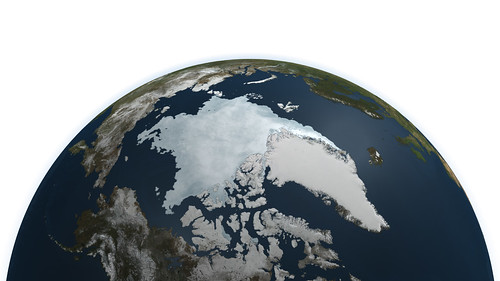Search Results for Tag: nasa
Is the ice-free north-pole just a matter of short-time?

Within this year’s summer period the arctic sea ice shield at the north pole melted dramatically to a new all-time low. The ice mass has fallen short of the record of 2007. And the low could get even lower, because the 2007 record was measured at 18 September. This year we saw the same record already in August. The ice usually melts until the mid of September and then starts again to grow during the winter period. But due to the large melting the new ice will be much thinner than usual. Scientists of the National Snow and Data Center explain that where have been an ice shield of a 3-4 meters just a few years ago, it’s possible to reach only 1-2 meters today. An ice free noth-pole could be the result, they say, followed by the irreversibility of the melting process. According to the Arctic Sea Ice Blog it’s just a question of when until we will see an ice free north pole.If you want to stay updated on that issue, there are lot’s of impressive and in somehow frightening opportunities. The picture on top of this post is provided by the Instituts for Arctic Climate Research at the University of Illinois. It’s going to be updated every day. So it will be possible to see the day the ice will be growing again. The website also offers a 30-day summary of the ice developement. You will also find tons of data about the planet’s ice shield’s via the National Snow and Ice Data Center.
But whats so bad about melting ice? Well, as Global Ideas Climate Expert Anders Levermann explained in one of his videos the arctic sea ice belongs to the earth’s tipping points. If the ice melts the dark ocean underneath will heat up and slowly melts even more ice. Here’s the video for you to see:
Arctic defrosting faster than ever
With the world expecting to celebrate world records at the London Olympics from today, the weather in recent weeks has delivered many high scores we should be less happy with: Record breaking high temperatures in the USA, droughts in Canada or deadly floods in Russia are just the most prominent examples.
Now there’s more. This summer, ice in arctic regions has been melting more extensively than ever seen before.
NASA scientists reported that in mid-July a whopping 97 percent of Greenland’s ice surface was melting. While the amount of surface melting can change extensively and in a matter of days (depending on the temperature of the air above), it’s never been observed to cover that large an area in more than 30 years of satellite observations.
Is this just a freak event or global warming in action? Scientists are careful not to draw a direct link between extreme weather events and climate change. For good reason: Some phenomena may not have been observed before, but scientists are not surprised to see them regardless of a global warming. Cores drilled out the Greenland ice sheets can help recover the temperature history for the place and indicate that extreme melting regularly occured every 150 years or so. This summer’s thawing episode is “right on time”, says one NASA glaciologist.
But the accumulation of extreme weather events is something you would plausibly expect under conditions of global warming, says Global Ideas climate expert Anders Levermann of the Potsdam Institute of Climate Impact Research. Even then, “we can’t say what the further impacts will be,” he cautions. In the case of Greenland “we don’t know what a period of extreme melting actually means except that in this moment more water is being lost and the water level is rising.”
Taking a long hard look at individual regions, however, can help establish more direct links between regional trends and global warming. At least 70 percent of the reduction of Arctic sea ice over the last 30 years may be man made suggests a study by a British-Japanese team of scientists. Here’s how the lead author puts it:





Feedback